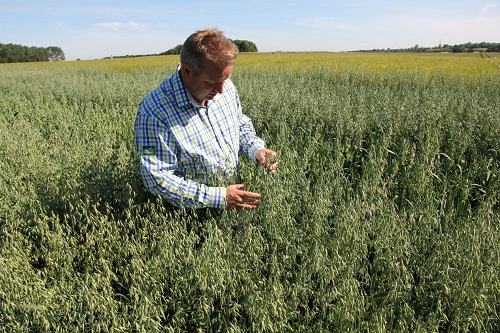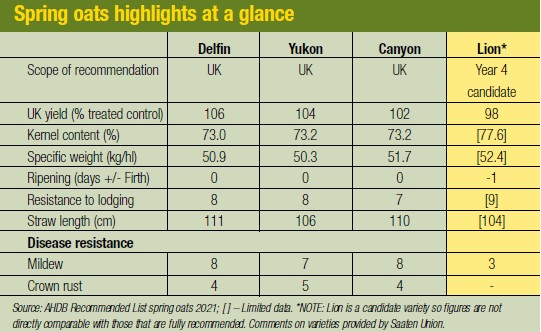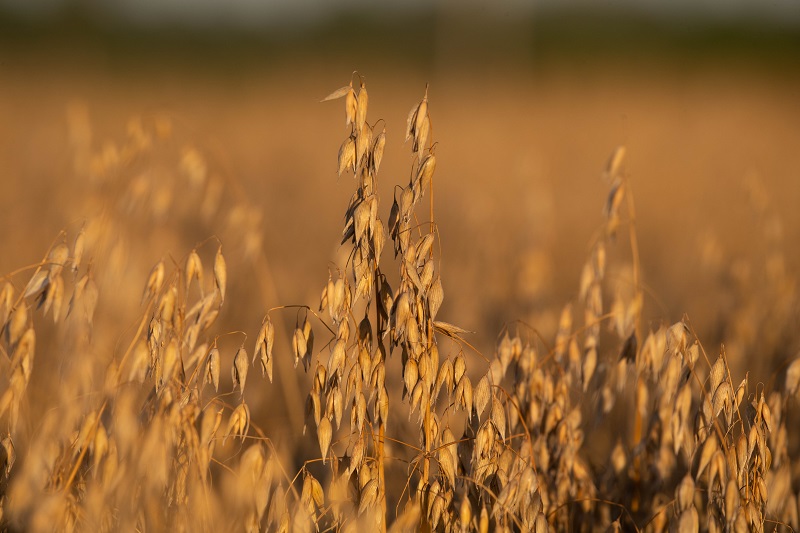Spring oats combine a food with recognised health benefits and a crop that leaves the soil in good heart. CPM explores the agronomic value and market prospects of the crop and leading varieties available for 2021.
We have extraordinarily good feedback from commercial mills – they’ve been euphoric.
By Tom Allen-Stevens
A crop that roots voraciously, bringing soil health benefits, that competes well against blackgrass and produces a food with recognised human health benefits – what’s not to like about oats?
“With the trend for more spring cropping, widening of rotations and less reliance on oilseed rape as a break, and with prospects for spring barley perhaps not as good as they were, spring oats are gaining favour,” notes Saaten Union UK cereals product manager Andrew Creasy.
“There’s strong demand, especially for milling oats, and unlike some other spring breaks, it’s a crop growers are familiar with. What’s more, the varieties now available do present growers with a nice range of options to fulfil some of the market opportunities.”

Oats cover the ground quickly, competing against blackgrass, says Andrew Creasy, and they leave a good tilth.
Saaten Union UK represents leading German plant breeder Nordsaat, with whom Elsoms have an exclusive arrangement in the UK. Andrew’s also been working with UK oat processors to help bring to the UK germplasm specifically adapted for the northern European climate that has real domestic promise. The collaboration has resulted in Lion, a milling-quality variety that joins a strong offering of high-yielding feed types.
So what qualities make a spring oat resilient within the arable rotation? “Agronomically, growers look primarily for a dependable yield. But one of the biggest benefits of oats is their competitive nature – they cover the ground so quickly, which is a key feature, especially in a spring-sown situation and where blackgrass is an issue,” Andrew points out.
“Spring oats are also strong-rooting, which makes them good soil conditioners, especially on heavy-land sites. They have a reputation for leaving the land hungry, but I’d say they leave a good tilth and they’re a take-all break so a good entry for a first wheat.”
Other qualities to look for are straw strength and height – oats grow tall so benefit from use of growth regulators. “PGRs should be matched to season – if it’s cool and dry during stem extension, their use can check growth harshly. But oats are vulnerable to brackling and lodging later on if the canopy isn’t well managed,” he advises.
Compared with other cereals, disease is less of a consideration. “Mildew can be an issue for some sites, while late in the season crown rust can be a problem – a bit like brown rust in wheat. But both are very easily managed in susceptible varieties with a one or two-spray fungicide programme.”
When it comes to the market, oats score favourably, with domestic demand enjoying a steady rise of around 10% per year. “But it is important to have a market lined up for your crop – the spot feed market has relatively poor returns,” Andrew notes.
“Processors look for high kernel content – the proportion of the grain that can be utilised – and hullability, which is the ease with which the hull is separated through the mill. Oats have either a white or more yellow hull, which affects flour colour, and some markets prefer a whiter hull, especially in Northern Ireland and certain export destinations.”
Most spring oat varieties are husked, which means they retain their hull through the combine, he explains. “The hull makes up about 30% of husked varieties, which explains the lower apparent yield of naked types. But most processors prefer the quality of husked varieties, despite the need to de-hull them.”
Richardson Milling, with a base at Bedford, and Quaker with mills in Scotland are two key UK buyers for human consumption, he adds. “Mills have their preferred varieties, with Quaker favouring Canyon from Scottish growers and Richardson looking very favourably on Lion. There’s a strong demand from some outlets for feed varieties, especially in the South West.”
The Saaten Union lines, marketed through Elsoms, have come from Nordsaat’s North European breeding programme, based on the Rügen peninsular in N Germany. The company has the largest multiplication area of spring oats across Europe.
“One trait in particular we’ve focused on for the N European market is straw strength,” notes oat breeder Dr Steffen Beuch, who heads up the breeding station and has developed the company’s oat breeding lines over 20 years into the market-leading position.
“PGRs aren’t allowed in some of the markets of this region. There’s a general preference for white-hulled varieties, while yield stability and foliar disease resistance are key requirements for UK and Ireland.”
Lion has been a particular success for Nordsaat, he notes. “It’s short, early, very stiff with a very stable yield. It’s not the highest yielder but adapts well over many different sites which is a mark of consistency.
“Lion’s stand-out feature is its quality – it has the best kernel content of all spring varieties, coming out consistently high in all trials and all years, with a high extraction rate and good hullability. We have extraordinarily good feedback from commercial mills across Germany – they’ve been euphoric.”
Steffen expects Lion to get a similar reception from UK millers. “It’s almost ten years since we introduced our first spring oat, Canyon, to the UK, which now has some well established market outlets. Lion represents a step-up on quality.”
Yukon he calls a “classical” oat, performing well in low input situations. “It has very good standing ability and is short. Delfin is similar although has slightly better quality, but the remarkable aspect of this variety is its yield – it’s the highest yielding spring oat across Europe. It delivered a staggering 13t/ha in a trial in Sweden, which is the highest I’ve seen for a spring oat,” he notes.
He now has his eyes set on Scotty and Tasman, both candidates for the UK and both with Yukon in their parentage. “Scotty has been yielding top consistently across N Europe. It combines this with early maturity, good straw stiffness, disease resistance and quality. This isn’t as high as Lion’s, although it’s a white-hulled variety. Tasman is even higher-yielding, especially in untreated trials, so we’re expecting a strong uptake among organic growers. It has good specific weight and hullability.”
Growers who suffer mildew will benefit from very high ratings for the disease in the future – two genes have been identified and crossed into lines that are making their way through the N European programme, reports Steffen. But an issue identified by breeders is a widening yield gap between the best of new material in trials and on-farm spring oat performance – higher than in wheat or barley.
“The potential is there for UK growers to significantly raise the returns from spring oats with good management. Meanwhile we’re using the latest breeding techniques, such as genomic selection, to advance the spring oat lines, and the result is really good diversity and robustness in the traits we’re now bringing forward. That will ensure resilience for rotations across Europe in years to come,” he concludes.
Comparison of spring cereals

Lion in the mill attracts attention
Initial results from milling spring oat newcomer Lion suggest good prospects for the variety in domestic markets, as well as for export destinations.
Richardson Milling (UK) is the biggest business-to-business buyer of oats in Europe, notes the firm’s agronomy manager Brin Hughes. It’s owned by Richardson International, Canada’s largest agribusiness, that purchased European Oat Millers from the Jordan family in 2017. Along with Jordans, Dorset Cereals and Oatibix (the oat-based version of Weetabix) are among the popular brands supplied by the Bedford mill, from oats and other cereals sourced mainly within an 80-mile radius.
“We’ve seen a steady growth in demand that’s doubled over 20 years,” says Brin. “The entire UK oat market is about 1M tonnes, with human consumption taking about half. The strength in demand is largely down to the health benefits.”
Oats are proven to be high in beta glucans, a soluble dietary fibre strongly linked to improving cholesterol levels and boosting heart health. “In processing terms, the key for us is an oat with good hullability and low hulling losses. These are related to kernel content, but also with how the oats travel through the mills and how easily the hull shatters – some varieties dehull more easily than others. Every mill has its own set-up so you’ll find millers differ with their favoured varieties,” he explains.
The colour of the oats – the whiteness of the finished product – is less of a concern for the Bedford mill. A typical contract will specify more than 50kg/hl specific weight with less than 6% screenings. “While we’re considering adding hulling losses, we don’t currently have a contract spec but look for varieties with less than 30%. Winter varieties tend to have lower screenings and are the only ones we buy on contract, comprising around 80% of throughput, although we process a considerable spring-sown crop.”
Brin works closely with breeders to identify and encourage varieties that perform well through the mill. “Elyann has historically been our preferred spring oat, but what we’ve seen of Lion this year is looking very promising. Bearing in mind harvest quality was generally very good, Lion achieved hulling losses from the limited samples we tried as low as 20%, which is fantastic. This is a variety we are interested in.”
Harvest 2020 contrasts starkly with the previous two seasons, however. “We’ve had two horrendous years for the spring crop, with drought and poor weather hitting specific weight, and screenings over 10%. We don’t yet know how Lion will perform in a more challenging year, but currently we’re happy with it for 2021 plantings.”
He’s keen for growers with attention to detail to get involved with oats. “It’s a fascinating crop, with very elastic potential to adapt to its situation, but we don’t don’t know enough about it – oats don’t attract as much R&D investment as wheat or barley.”
He advises sowing early, ideally Feb or early March, at a relatively low seed rate of 300 seeds/m² to encourage roots to explore. Around 130kgN/ha gives the crop what it needs, split 30% in the seedbed and 70% soon after emergence. “Although the crop’s seen as low input, in my experience a decent two-spray triazole/strobilurin fungicide programme usually pays dividends.
“But we’re way off understanding some of the details about this crop, such as the optimum grains per panicle and how to balance N and PGR use to coax the best performance. There’s real scope for the professional grower to get a really healthy return from some careful crop management,” notes Brin.

Delfin has not only the highest treated yield but also tops the spring oat RL with its untreated performance. This is coupled with one of the strongest scores on the RL for mildew and good stem stiffness, making the variety suitable for organic and low input situations. Performing particularly well in the East, its main market is for feed, although there are milling outlets that take the variety.
Yukon has a very similar profile to Delfin, with the second highest untreated yield on the RL. It has a slightly lower mildew score, but performs better on crown rust, is slightly shorter and stiffer.
Canyon has the edge on quality, with similar disease scores and straw stiffness to its stable mates. The first Nordsaat variety to make it onto the UK RL, it retains a mid-range yield performance that’s dependable and is one of the widest grown across Europe. It’s a yellow-hulled variety used by Quaker, making Canyon a popular choice for growers in the north of England and Scotland.
Lion is the newcomer, still a candidate on the RL, but with very strong scores for kernel content and specific weight in a yellow-hulled variety. The resulting high extraction rate is drawing favour from millers across Europe. Stiff-strawed, it’s also significantly earlier maturing, although mildew is one disease to watch for.
Rotational resilience
Less oilseed rape, spring cropping, a focus on improving soil health and building carbon all rely on a cropping rotation that is resilient. Each crop must deliver a profit on the year while the rotation as a whole should ensure the farming business remains sustainable for years to come.
In this series, CPM partners with Elsoms to look at the opportunities offered by cereals other than wheat and delves into the genetics behind them. Through privileged access to the company’s staff and resources, these articles explore rotations that secure a reliable return today and offer bright prospects for the future.
Elsoms Seeds is the UK’s leading independent seed specialist and plant breeder. The company’s experienced, specialist staff combine a passion for high quality vegetable and agricultural seed with the latest in plant-breeding research and seed technology. This ensures a focus on high performance and low-risk varieties, building resilience into rotations for years to come.




